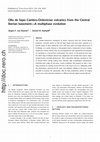Papers by Gerard Stampfli
Tectonophysics, Nov 1, 2013
ABSTRACT The Variscan structures of the Caucasus region are still quite difficult to decipher, th... more ABSTRACT The Variscan structures of the Caucasus region are still quite difficult to decipher, they certainly deserved some in depth investigations in the future. Thus, it is right to question any paleogeographic models proposed in that area, as made by D.A. Ruban. We present here the arguments that we used to decide on the distribution of the terranes in that region. The Transcaucasus massif is regarded as pertaining to the Galatian super-terrane, whereas, the Great Caucasus terrane belongs to the Hanseatic ribbon terrane. The latter was a part of Hunia, detached from Laurussia in the Devonian.

Terra Nova, Aug 5, 2018
The Cambro-Ordovician rhyodacitic to dacitic volcanics from the Central Iberian basement, current... more The Cambro-Ordovician rhyodacitic to dacitic volcanics from the Central Iberian basement, currently known as Ollo de Sapo (toads eye), have been reported as a specific group of felsic porphyritic rocks with blue quartz and large phenocrysts of K-feldspar, in a partly vitreous or fine-grained matrix. Interpreted to form Cambro-Ordovician volcanic domes, they are accompanied by tuffs, ignimbrites and products of reworking in a near-surface environment. The coarse-to fine-grained rocks exhibit rather large K-feldspar phenocrysts, plagioclase and rounded blue quartz, representing former corroded phenocrysts. Their colouration indicates unmixing of TiO 2 at around 900°C during cooling from relatively high crystallisation temperatures, indicating their origin at hot lower crustal conditions. We propose at least a twostep evolution (1) starting around 495 Ma in the lower crust of a collapsing cordillera, generating a phenocryst-rich mush and adiabatic melting of the lower crustal protolith to produce the spectacular Ollo de Sapo porphyrites, before (2) magma ascent and crustal extension leading to a different thermal regime around 483 Ma.
... Bulletin de la Societe Geologique de France Email Content Delivery ... Institution: Stanford ... more ... Bulletin de la Societe Geologique de France Email Content Delivery ... Institution: Stanford Highwire Sign In as Member Bulletin de la Societe Geologique de France; May 1993; v. 164; no. 3; p. 395-414 ...
... de l'ouverture qui s'ensuit des océans Paléo-Téthysien et Uralien, ... more ... de l'ouverture qui s'ensuit des océans Paléo-Téthysien et Uralien, (2) l'extension d'arrière arc dévonienne rapportée à l'évolution des systèmes de subduction de la Paléo-Téthys et de l'Océan Uralien, (3) les phases terminales permo-carbonifères de l'orogenèse hercynienne, (4 ...
Birkhäuser Basel eBooks, 1995
Tectonophysics, Feb 1, 1997
As a result of recent deep reflection and refraction seismology the crustal structure of the West... more As a result of recent deep reflection and refraction seismology the crustal structure of the Western Alps is now quite well-defined. However, this raises the question of what is present below the Moho, such as a crustal eclogitic root. This study attempts to estimate the volume of this eclogitic root on the basis of palinspastic reconstructions. Even with a minimum
Springer eBooks, 2004
ABSTRACT
Birkhäuser Basel eBooks, 1995

Palaeogeography, Palaeoclimatology, Palaeoecology, 2007
The Talea Ori unit is the lowermost known tectonic unit of Crete and the most external part of th... more The Talea Ori unit is the lowermost known tectonic unit of Crete and the most external part of the Hellenides. Its stratigraphy ranges from Late Carboniferous to Oligocene and outcrops of the lower part are only known in the Talea Ori mountains (central Crete). In this area, a black sandstone at the base of the Galinos Beds, thought to be the oldest formation, contains zircons which were dated using the single grain evaporation method. The majority of these grains yielded Late Carboniferous ages (Variscan), while a small group yielded Early Proterozoic ages. The age distribution of these zircons suggests that, at the Carboniferous-Permian boundary, not much of the older North Gondwanan basement was exposed and that a river system carried detrital material from the Variscan belt towards the forming Neotethyan rift. Additionally, higher up in the stratigraphy benthic foraminifers (miliolids) were found in clasts from a conglomerate which was so far thought to be of Early Triassic age [

Marine and Petroleum Geology, Feb 1, 1996
Three-dimensional sequence stratigraphy is a potent exploration and development tool for the disc... more Three-dimensional sequence stratigraphy is a potent exploration and development tool for the discovery of subtle stratigraphic traps. Reservoir morphology, heterogeneity and subtle stratigraphic trapping mechanisms can be better understood through systematic horizontal identification of sedimentary facies of systems tracts provided by three-dimensional attribute maps used as an important complement to the sequential analysis on the two-dimensional seismic lines and the well log data. On new prospects as well as on already-producing fields, the additional input of sequential analysis on three-dimensional data enables the identification, location and precise delimitation of new potentially productive zones. The first part of this paper presents four typical horizontal seismic facies assigned to the successive systems tracts of a third-or fourth-order sequence deposited in inner to outer neritic conditions on a clastic shelf. The construction of this synthetic representative sequence is based on the observed reproducibility of the horizontal seismic facies response to cyclic eustatic events on more than 35 sequences registered in the Gulf coast Plio-Pleistocene and Late Miocene, offshore Louisiana in the West Cameron region of the Gulf of Mexico. The second part shows how threedimensional sequence stratigraphy can contribute in localizing and understanding sedimentary facies associated with productive zones. A case study in the early Middle Miocene Cibicides opima sands shows multiple stacked gas accumulations in the top slope fan, prograding wedge and basal transgressive systems tract of the third-order sequence between SB 15.5 and SB 13.8 Ma.
First Break, Sep 1, 1994
ABSTRACT

Episodes, Sep 1, 2004
Geological research on the Mediterranean region is presently characterized by the transition from... more Geological research on the Mediterranean region is presently characterized by the transition from disciplinary to multidisciplinary research, as well as from national to international investigations. In order to synthesize and integrate the vast disciplinary and national datasets which are available, it is necessary to implement maximum interaction among geoscientists of different backgrounds. The creation of project-oriented task forces in universities and other research institutions, as well as the development of large international cooperation programs, is instrumental in pursuing such a multidisciplinary and supranational approach. The TRANSMED Atlas, an official publication of the 32nd International Geological Congress (Florence 2004), is the result of an international scientific cooperation program which brought together for over two years sixtythree structural geologists, geophysicists, marine geologists, petrologists, sedimentologists, stratigraphers, paleogeographers, and petroleum geologists coming from eighteen countries, and working for the petroleum industry, academia, and other institutions, both public and private. The TRANSMED Atlas provides an updated, synthetic, and coherent portrayal of the overall geological-geophysical structure of the Mediterranean domain and the surrounding areas. The initial stimulus for the Atlas came from the realization of the extremely heterogeneous nature of the existing geological-geophysical data about such domain. These data have been gathered by universities, oil companies, geological surveys and other institutions in several countries, often using different procedures and standards. In addition, much of these data are written in languages and published in outlets that are not readily accessible to the general international reader. By synthesizing and integrating a wealth of preexisting and new data derived from surficial geology, seismic sections at various scales, and mantle tomographies, the TRANSMED Atlas provides for the first time a coherent geological overview of the Mediterranean region and represents an ideal springboard for future studies.
Schweizerische Mineralogische Und Petrographische Mitteilungen, 1989
... Titre du document / Document title. Les Schistes lustrés à ophiolites de la nappe du Tsaté: u... more ... Titre du document / Document title. Les Schistes lustrés à ophiolites de la nappe du Tsaté: un ancien prisme d'accrétion issu de la marge active apulienne? Auteur(s) / Author(s). MARTHALER M. (1) ; STAMPFLI GM ; Affiliation(s) du ou des auteurs / Author(s) Affiliation(s). (1) Univ ...
69th EAGE Conference and Exhibition incorporating SPE EUROPEC 2007, 2007
P151 Multi-Sources Data Integration for Global Scale Paleo-Plate Tectonics Modelling C. Hochard* ... more P151 Multi-Sources Data Integration for Global Scale Paleo-Plate Tectonics Modelling C. Hochard* (Institute of Geosciences and Environment) & G.M. Stampfli (Institute of Geosciences and Environment) SUMMARY Reconstructions of past plate motions offer an ideal framework for other geological paleo-geographical paleo-oceanographic and paleo-climatology studies. Defining plate positions and relationships through time must follow a few relevant rules to be consistent. Mainly driven by processes occurring at their limits the plates behaviour cannot be modelled without reconstructing these limits and the disappeared oceans. By integrating numerous data sources (including field geology seismic data paleomagnetism paleobiogeography...) and various constraints (maximum plates velocity ocean

First Break, Dec 1, 2007
In the last decade, the sophistication of three-dimensional (3D) seismic data has been applied in... more In the last decade, the sophistication of three-dimensional (3D) seismic data has been applied increasingly to the more precise definition of geological structures containing oil and gas accumulations. In favourable circumstances, it is even possible to define the limits of the hydrocarbons themselves and, in rare cases, show the retreat of hydrocarbon-water contacts in response to sustained oil and gas production. In the early days, 3D seismic data were interpreted in a manner comparable to the interpretation of a grid of two-dimensional (2D) profiles. Equispaced in-lines and cross-lines were abstracted from the total data volume and, with the additional benefit of arbitrary lines and time-slices, interpreters were able to construct time contour maps of selected horizons with increased confidence. However, a significant percentage of the total volume of acquired data was by-passed in this process, and it was not until the advent of interactive trace interpretation systems (the so called work stations) that the interpretation of the full data volume became feasible. Feasibility turned into reality with the development of new and powerful automatic tracking (horizon picking) programs. These enable the interpreter to incorporate data from every common midpoint (CM) in the data volume. In some more advanced programs, selected ‘seed’ lines, which are initially interpreted by hand, are fed to the automatic tracking programs which, in turn, extrapolate the horizon pick until every CMP in the survey has been covered. For any given reflection horizon it is thus possible to generate files of two-way time, amplitude, instantaneous phase, etc. in a framework of x,y coordinates. These files permit the calculation of additional horizon attributes, especially dip and azimuth (Shell Internationale Petroleum Maatschappij BV 1988. Horizon processing techniques for recognition of structural geology on 3D seismic. Research Disclosure 29473). This paper is concerned with the determination and display of the latter two attributes. It will be shown that, with carefully chosen colour display parameters, subtle laterally continuous features that would have been overlooked during traditional interpretation may be interpreted with relative ease and confidence as having geological significance. The techniques employed have much in common with those used in photogeology.











Uploads
Papers by Gerard Stampfli